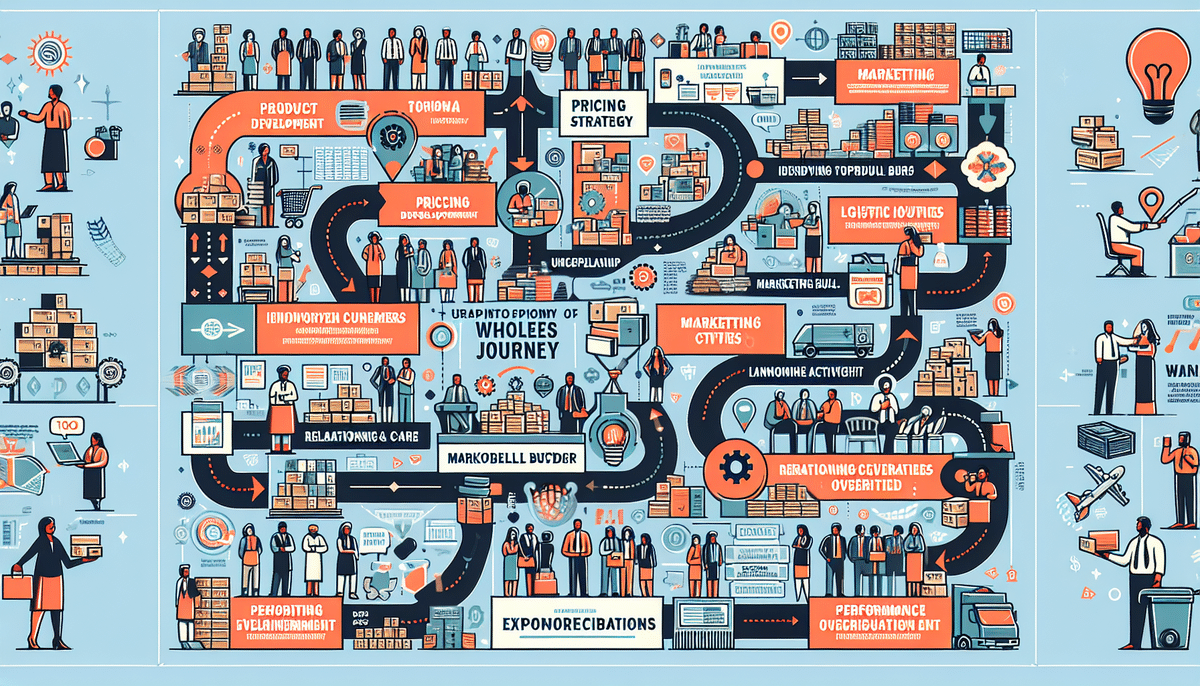Understanding Wholesale Sales Channels
Wholesale sales involve selling products in bulk to other businesses rather than directly to consumers. While the margins on individual sales may be lower compared to retail, the higher volume can compensate for reduced margins, providing a steady revenue stream for your business.
One significant advantage of wholesale sales is the ability to reach a broader audience. By partnering with other businesses, you can tap into their existing customer base, expanding your market reach beyond what could be achieved solo. Additionally, wholesale sales help build relationships within your industry, potentially leading to valuable partnerships and collaborations.
However, successful wholesale operations require meticulous planning and execution. Key factors to consider include pricing, packaging, shipping logistics, and marketing strategies tailored to wholesale buyers. With the right approach, wholesale sales can be a lucrative and stable revenue source for your business.
Choosing the Right Wholesale Sales Channel
Selecting the appropriate sales channel is crucial for the success of your wholesale operations. The optimal channel depends on factors like your target market, product types, and business objectives. Here are the primary wholesale sales channels to consider:
Online Marketplaces
Platforms such as Alibaba, Amazon Business, and ThomasNet offer vast exposure to potential wholesale buyers. These platforms provide access to a large pool of buyers but also come with increased competition. Ensuring competitive pricing and unique product offerings is essential to stand out.
Trade Shows
Trade shows provide opportunities to showcase your products directly to targeted buyers. They facilitate face-to-face networking and relationship building, though they require significant investment in time and resources. According to Statista, the global trade show market was valued at approximately $50 billion in 2022, underscoring their importance as a wholesale channel.
Direct Sales to Retailers
Direct sales involve building relationships with individual retailers, offering a personalized approach. This method allows for tailored negotiations and can lead to long-term partnerships, though it may involve a more substantial initial effort in relationship-building.
Researching and Targeting Your Wholesale Market
Thorough market research is essential to identify and understand your target wholesale buyers. Determine the types of businesses that would benefit from your products, their purchasing preferences, and the price points they are willing to pay.
Market Research Techniques
- Surveys and Focus Groups: Gathering direct feedback from potential buyers can provide valuable insights into their needs and preferences.
- Industry Analysis: Reviewing industry reports and trends helps in identifying market gaps and opportunities. Resources like IBISWorld offer comprehensive industry research.
- Competitive Analysis: Understanding your competitors’ strategies can help in differentiating your offerings and positioning your products effectively.
By understanding your target market, you can make informed decisions regarding product development, pricing, and marketing strategies, increasing the likelihood of success in wholesale sales.
Creating an Effective Wholesale Pricing Strategy
Pricing is a critical element of wholesale operations. Your pricing strategy should balance competitiveness with profitability, factoring in costs of goods sold, operating expenses, and market pricing standards.
Factors to Consider
- Cost Analysis: Calculate all costs involved in producing and delivering your product to ensure profitability.
- Competitive Pricing: Analyze competitors’ pricing to position your products effectively in the market.
- Volume Discounts: Offering discounts for larger orders can incentivize bulk purchases, increasing overall revenue. For instance, providing a 10% discount for orders exceeding 100 units can encourage larger sales.
Regularly reviewing and adjusting your pricing strategy in response to market conditions, production costs, and consumer demand is essential for maintaining competitiveness and profitability. Data-driven approaches, such as employing price optimization software, can assist in making informed pricing decisions.
Developing a Comprehensive Wholesale Marketing Plan
Effective marketing strategies are essential to attract and engage potential wholesale buyers. A comprehensive marketing plan should encompass various tactics tailored to reach and persuade your target audience.
Marketing Tactics
- Targeted Email Campaigns: Personalized emails to potential buyers can increase engagement and response rates.
- Social Media Advertising: Platforms like LinkedIn and Instagram can be leveraged to advertise your products to relevant business audiences.
- Trade Shows and Events: Participating in industry events provides opportunities to showcase your products and network with potential buyers.
Incentives and Promotions
Offering discounts or special promotions to first-time buyers can incentivize new customers to try your products, potentially leading to repeat business. Additionally, implementing a referral program can help generate new leads through existing customers.
Building strong relationships through regular communication, excellent customer service, and personalized product recommendations fosters trust and loyalty, enhancing your reputation in the industry.
Building and Maintaining Relationships with Wholesale Buyers
Maintaining robust relationships with your wholesale buyers is pivotal for sustained success. Strong relationships lead to repeat business, referrals, and a solid reputation in the industry.
Customer Service Excellence
- Responsiveness: Promptly addressing inquiries and issues demonstrates reliability and builds trust.
- Personalization: Tailoring your interactions and offerings to the specific needs of each buyer enhances their experience and satisfaction.
- Incentives for Loyalty: Offering discounts or special terms for repeat orders encourages continued business.
Communication Strategies
Regular updates about new products, changes in inventory, or company news keep your buyers informed and engaged. Utilizing email newsletters or inviting buyers to product launches and trade shows can enhance their connection to your brand.
Handling Logistics and Fulfillment in Wholesale Operations
Efficient logistics and fulfillment are essential for meeting wholesale orders' demands promptly and cost-effectively. Proper management ensures that products reach buyers in good condition and on time.
Inventory Management
- Inventory Tracking: Utilizing inventory management software helps in monitoring stock levels and anticipating demand. Solutions like TradeGecko can streamline this process.
- Demand Forecasting: Accurate demand forecasting prevents stockouts and overstocking, optimizing inventory levels.
Shipping and Handling
Partnering with reliable logistics providers ensures that orders are shipped efficiently. Consider factors like shipping costs, delivery times, and reliability when choosing your logistics partners.
Returns and Exchanges
Establishing a clear and fair returns policy is important for maintaining buyer satisfaction. A transparent policy regarding returns and exchanges can prevent misunderstandings and foster trust.
Packaging Standards
Wholesale buyers may have specific requirements for product packaging and labeling. Ensuring your products meet these standards enhances professionalism and readiness for retail distribution.
Managing Inventory and Stock Levels
Accurately managing inventory and stock levels is critical to fulfilling wholesale orders in a timely and efficient manner. Effective inventory management helps in predicting demand, avoiding stockouts, and minimizing excess stock.
- Inventory Software: Implementing inventory management systems, such as TradeGecko, can automate tracking and provide real-time updates.
- Overestimating Demand: It's prudent to slightly overestimate demand to account for unexpected orders, ensuring you can meet buyer needs without delays.
Analyzing the Performance of Your Wholesale Sales Channels
Regularly analyzing the performance of your wholesale sales channels is essential to identify areas for improvement and optimize your strategies. Key performance indicators (KPIs) to consider include:
- Conversion Rates: Measure the percentage of leads that convert into actual sales to assess the effectiveness of your sales efforts.
- Average Order Value: Track the average size of orders to understand purchasing behaviors and adjust your pricing or discount strategies accordingly.
- Customer Retention Rates: Evaluate how well you retain customers over time, which reflects on the quality of your relationships and customer satisfaction.
Tools like Google Analytics and customer relationship management (CRM) systems can aid in tracking and analyzing these metrics.
Scaling Up Your Wholesale Operations
Once you've established a successful wholesale operation, you may seek opportunities to scale up your sales. Scaling can involve expanding into new markets, increasing your product offerings, or investing in additional sales personnel.
Expansion Strategies
- New Markets: Research and enter new geographic or niche markets where there is demand for your products.
- Product Line Expansion: Introduce new products that complement your existing offerings to attract a broader range of buyers.
- Sales Team Growth: Hire and train additional sales staff to increase your outreach and manage a larger customer base.
Scaling requires careful planning to ensure that your infrastructure, supply chain, and organizational capacity can support increased demand without compromising quality or customer satisfaction.
Best Practices for Setting Up and Managing Wholesale Sales Channels
Adhering to best practices can significantly enhance the effectiveness of your wholesale operations. These practices include:
- Clear Communication: Maintain open and transparent communication with your buyers to build trust and address any concerns promptly.
- Excellent Customer Service: Provide responsive and helpful customer service to ensure buyer satisfaction and foster long-term relationships.
- Demand Anticipation: Use forecasting tools to predict demand trends, helping you manage inventory and meet buyer needs efficiently.
- Quality Assurance: Ensure consistent product quality to maintain your reputation and meet buyer expectations.
Common Mistakes to Avoid When Managing Wholesale Sales Channels
Avoiding common pitfalls can set your wholesale operations up for long-term success. Common mistakes include:
- Underestimating Demand: Failing to accurately predict demand can lead to stockouts or excess inventory, both of which can impact profitability.
- Overcommitting to Buyers: Taking on orders that exceed your production or fulfillment capacity can strain your resources and damage relationships.
- Neglecting Logistics and Fulfillment: Inadequate attention to logistics can result in delayed shipments and dissatisfied buyers.
- Poor Pricing Strategies: Not pricing products appropriately can erode profit margins or make your offerings uncompetitive.
By being aware of these common mistakes and proactively addressing them, you can enhance the efficiency and effectiveness of your wholesale sales channels.
By following these strategies and best practices, you can establish and manage successful wholesale sales channels that provide a reliable revenue stream for your business. Stay customer-focused, continually analyze your performance, and be adaptable to growth and market changes. With the right approach, your wholesale operations can achieve significant growth and sustainability.




















